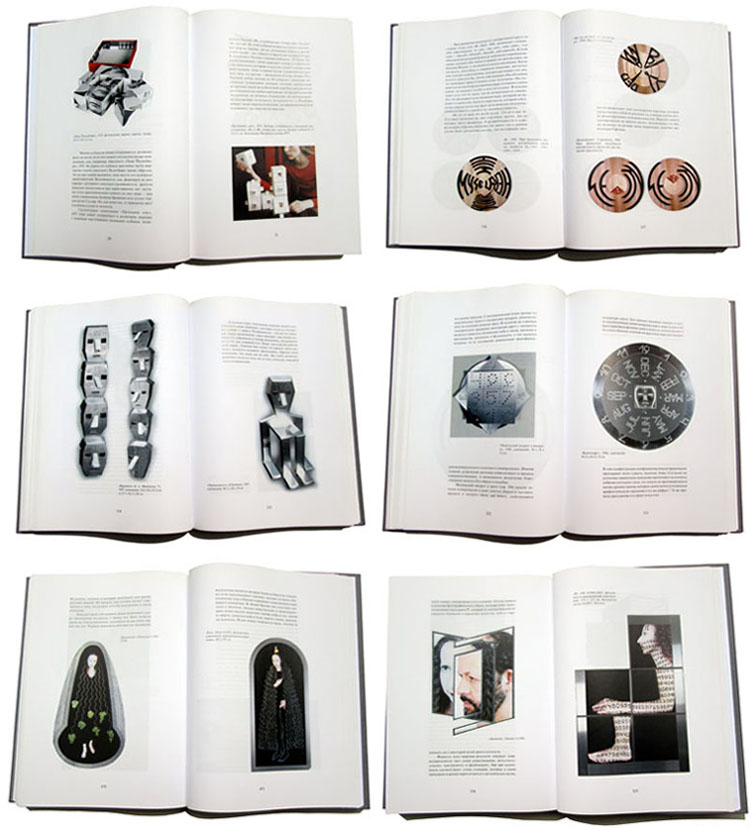
2012 - 1996
Римма и Валерий Герловины ÇКонцептыÈ, 2012, Библиотека московского концептуализма Германа Титова.
Подробнее
о книге, рецензии,
видео...

Moscow Conceptualism in Context, ed. Alla Rosenfeld, essay by Rimma Gerlovina, Valeriy Gerlovin "Trespassing", Prestel, 2011 (link to PDF)

ÒЭти странные семидесятые, или потеря невинностиÓ, Кизевальтер Георгий, Новое литературное обозрение, Москва, 2010
Статья Риммы и Валерия Герловиных ÒРетроперспективаÓ (Полный текст)
Выставка и книга Gender Check, Museum Moderner Kunst Stiftung Ludwig, Wien, Austria and Verlag der Buchhandlung Walther KŸnig, Cologne
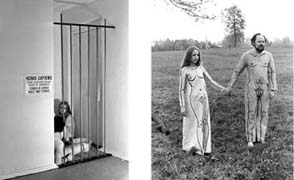
"It was first in the works by Rimma and Valeriy Gerlovin in the late 1970s that the semiotics of the male and the female, the juxtaposition between the body and spirituality, became the material for conceptualization... When they painted naked body silhouettes over their white dresses their intention was to say that the body was the garment for the soul and also its cage. In other words, the body in these project became the evidence of its incorporeal precondition."
Keti Chukrov, "In the Trap of Utopia's Sublime Between Ideology and Subversion", Gender Check, Museum Moderner Kunst Stiftung Ludwig, Wien, Austria and Verlag der Buchhandlung Walther KŸnig, Cologne, 2009,pp. 34, 208. (more)
"В динамике настоящего всегда существует два плана. Это план подлинного участия каждого художника в процессе, и здесь художники делятся на просто художников, даже гениальных, и художников тектонического значения, то есть тех, кто привносит некоторые изменения в картину современного искусства, в его языковые возможности... и создают новые языковые модели. Конечно, надо делать скидку на субъективность высказываний художников. И, тем не менее, таких художников не так уж много. Это, скажем, Герловины, это Комар и Меламид, это Кабаков, Булатов, это Монастырский и мы. Может быть, группа "Мухомор". Это касается периода 70-х – 80-х годов."
Анатолий Жигалов, из интервью с Анатолием Жигаловым и Натальей Абалаковой, "Синефатом", 6.11.2009

"На выставке "Русский леттризм" — от каждого по несколько известных работ. Только Римма и Валерий Герловины представлены привезенными из американского частного собрания тонкими и медитативными, еще не намозолившими глаз вещами." Ольга Кабанова "Искусство сквеpнословия" (Выставка "Русский леттризм", Центральный дом художника), "Ведомости", 15.6.2009.
"Как музейщик вы отобрали все самое представительное, качественное, яркое. А как коллекционер, что бы предпочли? - То, что еще не тронуто паутиной академизма. Уличные выступления, интерактив, словесные игры. Например, специально для выставки из Нью-Йорка были привезены работы Риммы и Валерия Герловиных - там есть манипуляция словами, перевертыши, игра. Этот диалог со зрителем, как и вообще все работы Герловиных..." Интервью с куратором выставки Андреем Ерофеевым, Advertology, 19.06.2009.
"Герловины внедрили в наше сознание слово "концепт", до них никто его даже не произносил. Хотя сейчас и говорят, что первые концептуалисты — это группа Монастырского, это неправда. Первые были Римма с Валерой."
Борис Орлов, "Собеседники", интервью с Борисом Орловым, "Искусство" 1-2, 2009.
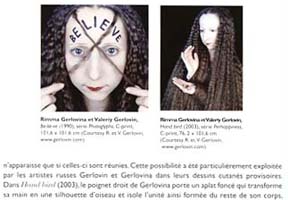
Hugues Marchal, "Intus et in cute", Le dessin hors papier, ed. Richard Conte, Pablications de la Sorbonne, Editions arts et monde, Paris, France, 2009,p.88. (link)

"The line, as an element of art, is alive with possibilities... In addition to defining shape, line can also function as form itself. Madonna and Child by Rimma Gerlovina and Valeriy Gerlovin is a revision of one of the most popular religious theme of the Renaissance. Taking their cue from works by artists such as Raphael, the Gerlovins use their signature combination of the body and braided hair to embroider a contemporary image of the Virgin Mary and the infant Jesus. The Gerlovins are the principal subject of their work, and in this piece, Gerlovina serves as the model for the Virgin. Braid extensions of her own sandy brown hair cascade from a sculptural head whose three-dimensionality stands in marked contrast to the flatness of the rippling braids, These braids flow into the contours of the Christ-child's body nested in the palm of a sculptured hand."
Lois Fichner-Rathus, Understanding Art, art-history textbook for colleges, Thomson Higher Education, Wadsworth, ed.8, 2008, pp. 25, 33.
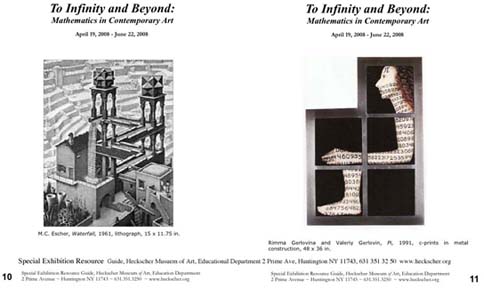
To Infinity and Beyond, Special Exhibition Resource Guide for Teachers, The Heckscher Museum of Art, Huntington NY, 2008 (link to PDF)

Holly Kite "Cyrilic Symbolism",The First Post, UK, Jan. 20, 2008.
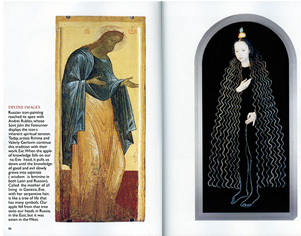
"Божественные образы. Расцветом русского иконописного искусства принято считать эпоху Андрея Рублева, в иконе которого "Иоанн Предтеча" можно увидеть внутреннее духовное напряжение. Современные художники Римма и Валерий Герловины продолжают эту традицию в своей работе "Ева". Гравитация яблока познания, которое падает на нашу "наевную" голову, тянет нас вниз до тех пор, пока это познание добра и зла не перерастает в мудрость (интересно, что "sapientia" на латыни тоже женского рода). Названная в Библии "матерью всего живого", Ева со змеящимися волосами подобна дереву жизни, которое имеет много символов и кодов. Наше яблоко с этого дерева упало нам на голову в России, на востоке, а было съедено на западе." "Cartier Art", 17, 2007, в трех изданиях на русском, английском и французском.
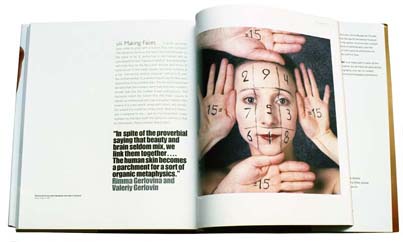
"If words can never fully come to grip with a human face, can numbers? The Gerlovins think so, but reject the "bookish page" as the place to do it, preferring to use human skin as parchment for their "figures of speech". And what better skin than on the face, both window and mirror of experience? In the magic square, any three numbers in a row - horizontal, vertical, diagonal – add 15, with the central number,5, a numerological sign for Man (also depicted as a five-pointed star)... The Gerlovins rejected the notion that the magic square is merely an intellectual exercise or a game: instead, they believe it is a key which, along with others, will eventually unlock the mysteries of the mind. "Abstract theory" one is tempted to say... but by inscribing their magic numbers on the face itself, the Gerlovins remind us that for the Greeks, theoria meant "direct sight." They say: "In spite of the proverbial saying that beauty and brain seldom mix, we link them together...The human skin becomes a parchment for a sort of organic metaphysics."
William A. Ewing, Face. The New Photographic Portrait, Thames & Hudson, 2006, pp.196-197.
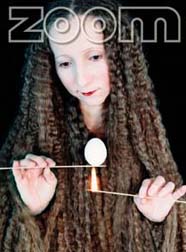
"Мы стараемся следовать нашим чувствам, а не инстинктам; следовать интеллекту, а не чувствам, следовать интуиции, а не интеллекту. Это процесс поиска артикуляции души среди множества чудес" — звучит несколько загадочно, почти эзотерически, но именно так Римма и Валерий Герловины описывают свою новейшую серию Perhappiness, где сопоставляются слова perhaps (возможно) и happiness (счастье). Рождаемые под знаком парадокса, работы этих двух художников простираются от инсталляции до перформанса, визуальной поэзии и фотографии.
И сама их жизнь отмечена постоянными переменами. В 1970-х они были частью московского андерграундного авангарда, а затем, в 1980, они оставили репрессивный мир Советской России и переехали в США. Они были тепло встречены миром западного искусства, их работы сразу же появились в экспозициях множества музеев, включая чикагский Институт искусств, Музей искусства Нового Орлеана, тельавивском Музее искусства, токийском Столичном музее фотографии и др. В Америке они создали ряд скульптур, но в первую очередь сосредоточились на серии фоторабот, которые назвали "фотоглифами" (буквально — "резьба светом", от греческого "phos—photos" — свет, и "glyphe" — вырезать), в которых они в основном использовали крупные планы со словами и криптограммами, аналогичными гравюрам, что мы находим и в их самой последней работе Perhappiness. Римма Герловина с её длинными, волнистыми, змеящимися волосами, которые могут трансформироваться в беспорядочные, соблазнительные, покаянные элементы, почти всегда является героиней этой двусмысленной и ироничной серии изображений."
Из вводной статьи Джильолы Фоски к интервью с Риммой и Валерием Герловиными в журнале "Zoom", в русском номере в июле-авг. 2006, а также в номерах на итальянском/английском и японском/английском. (линк к интервью)
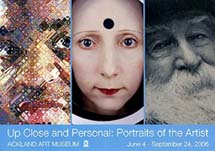
"Thematically organized, the exhibition highlights a wide range of attitudes and interpretations of life in the arts. Berenice Abbot's elegant photograph of Peggy Guggenheim (1926) and Andy Warhol's Liz (1964-65) express the cult of celebrity. Jim Dine's Self-portrait on J.D. Paper (1978) and Albert-Ernest Carrier-Belleuse's bronze sculpture of Young Raphael (1855) suggest the belief in the artist as genius. Symbolic portraits that allude to death, the passage of time, and the nature of spirituality are also represented by such works as Marc Chagall's Self-portrait with Angel, Hendrik Hondius' Portrait of Lucas van Leyden with Skull (before 1649), and Rimma Gerlovina and Valeriy Gerlovin's Point (1991-92)."
"Up close and Personal. Portrait of the Artist", Press Release, Ackland Art Museum, North Carolina, 2006.
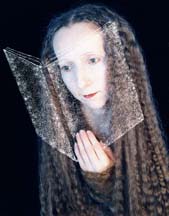
"Герловины
разработали
собственную
систему
выявления
глубинной
семантики
слов, основывающуюся
на
проекцировании
психологем и
мифологем
интуитивно
осваиваемого
пространства
на
эмпирическую
реальность с
последующей
визуализацией
метафорически
прочитаннного
дискурса.
Помимо
визуализации
текста
Герловины
следуют
познавательным
стратегиям,
принятым в
нумерологии,
кабалистике,
семиотике и
других
дисциплинах, реализуемым
в игровом
контексте...
пристально
всматриваются
в слова и
фразы в
поисках
альтернативного
значения. В
отличие от
поэтов ОБЭРИУ
они работают
преимущественно
с понятийными
и
абстрактными
словами, не
прибегая к
зауми.
Подобно
конструктивистам
и, в частности,
Александру
Родченко, они
визуализируют
и внедряют
слова в
изобразительное
пространство
рисунка или
фотографии,
подготавливая
таким
образом
экспериментальные
площадки для
своих
семантических
раскопок.
Исследовательские
технологии,
апробированные
в процессе
создания
траснформационных
композиций в
1989 году были
внедрены Герловиными
в новый вид
художественной
продукции:
"фотоглифы".
Термин
"фотоглиф"
явлается
производным
от двух
греческих
лексем, "свет"
и "резьба по дереву
или камню",
что
подчёркивает
идею многомерности
этих
визуально-лингвистических
композиций (Jacob
1993: np) ... В качестве
моделей для
фотоглифов
выступают оба
художника,
однако в
большинстве
композиций
текст и
рисунок
наносятся на
лицо и тело
Риммы
Герловиной.
Её
изысканные
черты лица,
длинные
вьющиеся
волосы – нити
жизни и алебстровая
кожа
позволяют
создавать
уникальные
эстетические
образы,
гармония
которых в значительной
мере
определяется
необычной
внешностью
модели (Stevens 1988: 114; McCracken 1991:
69; Weintraub, Danto, McEvilley 1996: 239)...
Название цикла (неологизм "Perhappiness", – образуется путём слияние слов perhaps, выражающем идею вероятности, возможности, и happiness, означающего "счастье"), как и сами последние работы Герловиных, свидетельствуют об изменении направления поисков скрытого смысла слов и понятий. Смелые лингвистичские эксперименты творческого дуэта уступили место многоплановой художественной метафоризации человеческого опыта, пристальное внимание к частным проявлениям которого позволяет заметить – а возможно и постичь – глубинную связь понятий, значений и концепций, определяющих суть нашего мироздания."
Татьяна Назаренко, "Семантика слова сквозь призму визуальности: траснпозиционные композиции и фотоглифы Риммы и Валерия Герловиных", альманах "Черновик", 20, 2005
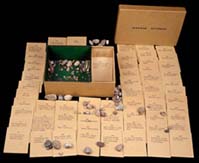
"In 1971, they began working together on a collaborative body of conceptual work that includes performance, photography, poetry, books, and objects. In 1974, Gerlovina produced a series of cubes made of fabric and paper with texts constituting of statements and poetic lines: for example, "Imagine this white cube as a red sphere" and "(The Soul) Don't open it or it will fly away." The placement of instructional, imaginative, and provocative statements within these playful boxes constituted a truly innovative aesthetic in the Soviet Union at that time. While it seems related to Fluxus projects, the Gerlovins were totally unaware of that international group until 1979. The Gerlovins played a leading role in producing a unique form of the artists' book... Stones is related to the Gerlovins' other language-based pieces and consists of a box of 160 stones and sixty-two cards with text on two sides, one in Russian and the other in English. They selected stones because they are "the most enduring items in nature," and they gave each stone its own story, sometimes linked to that of other stones:"#85 twin of #86; #124 is lost without further notice." By disrupting the expected, they seek to encourage thinking from another point of view. The humor, even absurdity, of some of the statements effectively delivers the artists' often metaphysical message to the spectator. In 1977, the same year this work was made, the Gerlovins produced some of the most pioneering performance art in the Soviet Union. Photographic documentation of these pieces and other works smuggled out of the country were shown at the Eastern European Biennale in Venice in1977."
Valerie Hillings, "Rimma Gerlovina and Valeriy Gerlovin", Russia, catalog of the exhibition at the Guggenheim Museum, NY and The Guggenheim Hermitage Museum, Las Vegas, 2005, p.53; catalog for Guggenheim Museum in Bilbao, Spain, p.63.
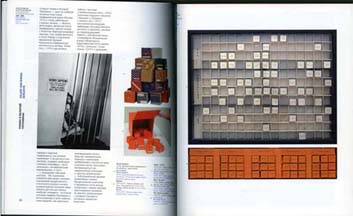
"С 1975 года активно перейдя к практике перформанса, Герловины привлекают к соучастию в нем зрителей, создавая свободную "игровую атмосферу", часто связанную с метафизическим переживанием, а часто с традициями смехотой культуры... Концептуальная аналитика у Герловиных почти всегда соседствует с живой эмоцией, транслируемой прямиком на зрителя..."
Из каталога к выставке "Сообщники. Коллективные и интеракционные произведения в русском искусстве 1960-2000", Третьяковская галлерея, специальный проект 1 Московской биеннале современного искусства, 2005.
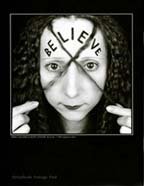
"The Gerlovins, who began their artistic collaboration and partnership in Soviet Russia during the 70's, exemplify this idea in their own lives and work. They share backgrounds in performance, conceptual sculpture, and visual poetry--all of which they eventually integrated into their work when they later arrived at photography in the mid-80's. Photographically, the Gerlovins have produced two notable and specific bodies of work, Photogyphs and Perhappiness, both of which are rich in metaphor, language, mythology, and symbolism."
Russell Joslin, Interview with Rimma Gerlovina and Valeriy Gerlovin, Shots magazine, #89, fall, 2005, back cover, pp.38-45, (link to the interview).
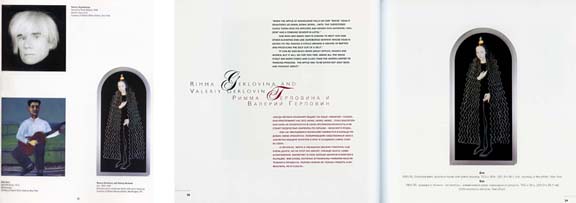
Book Art in Embassies Program 40th Anniversary, US Department of State, Washington, D.C., 2004, p. 35 (left) and Faces of America by Contemporary American Artists, spread from the catalog for the exhibition at Spaso House in 1997-2001, US Embassy in Russia, Moscow, pp. 28-29.
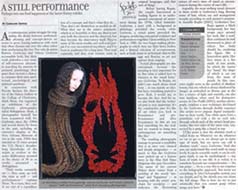
"As contemporary artists struggle for originality, the divide between aesthetically pleasing and concept-driven art seems to grow, leaving audiences with work that often chooses one over the other rather than synthesizing the two. Not only do artists Rimma Gerlovina and Valeriy Gerlovin accomplish both, but their work embodies a rare sense of self-conscious altruism. In searching for answers to personal ponderings, they grant their viewers a chance to examine their own intellectual, psychological, and spiritual questions."
Caroline Saffer, "A Still Performance. Spoleto Festival 2004 - Visual Arts Previews", Charleston City Paper, May 26, 2004.
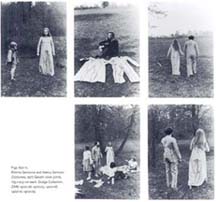
"In their performances the Gerlovins were primarily interested in various transitional states – from the physical to the metaphysical, from the external to the internal, from the visible to the invisible...The photographs of Mirror Game demonstrate the symbols of these process, documenting not so much specific actions or events as the internal, unseen playing of the consciousness. "Our action is a congealed 'performance of thought,'" the artists emphasized...
Photography permitted the artists to create a distinct space in which the world of abstract archetypes and symbols would be revealed. The Gerlovins, describing their photo-performances, said, "This is a new order on the basis of the old archetypal concepts; a still performance in the magnifying eye of photography... (The artists) have achieved a masterful blend of humor, perceptiveness, an inventiveness in their work."
Alla Rosenfeld, Beyond Memory. Soviet Nonconformist Photography and Photo-Related Works of Art, Zimmerly Art Museum and Rutgers University Press, NJ, 2004, pp.92, 93,139, 146.
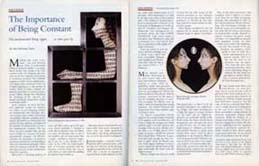
Neil deGrasse Tyson "The Importance of Being Constant", Natural History, 11, 2004.
"The better-known names of the players today come readily -- if not altogether fluently -- to the tongue: Ilya Kabakov, Vitaly Komar and Alexander Melamid, Grisha Bruskin, Leonid Sokov, Alexander Kosolapov, Eric Bulatov, Rimma and Valeriy Gerlovin...
One of the show's most interesting displays is the work of the Gerlovins, a husband and wife noted in Russia for their absurdist performance works as well as for their objects. Here they deal in arcane symbols that evoke myth and religion. In their startling, life-size photograph of Ms. Gerlovin, "Tree of Life" (1989), she appears in goddess like guise, her body concealed by a long fall of tightly waved hair, her face and chest marked in black with mystical writing. "Eve" (1993-95) presents her with hair and body extended by drawing on the photo, sporting an apple on her head. The work, with its virginal imagery, seems to hark back to the symbolism of Russian icons while sending them up."
Grace Glueck, "Nyet to Passé Soviet Realism..." The New York Times, December 5, 2003.
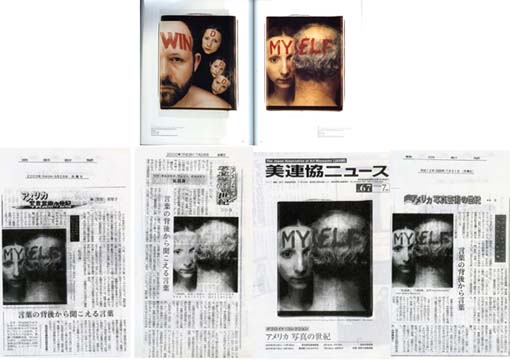
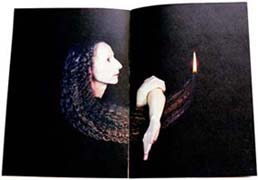
"By design, interpretation remains open in many of the stunning photographs produced by Rimma Gerlovina and Valeriy Gerlovin. Coming to the United States from Moscow in 1980, this multi-talented husband-and-wife team emerged from a world of performance and conceptual art. They were also leaders of an underground art movement, Samizdat, formed to circumvent Soviet censorship... For the Gerlovins, meaning remains an open-ended process, requiring active participation from the viewer. Understanding their art, including the photographic "still performances," begins with recognition of the balancing of opposites. As seen in examples from the exhibition, theirs is also an art tinged with wit and humor."
Dennis P. Weller, Is Seeing Believing? The Real, The Surreal, The Unreal in Contemporary Photography, North Carolina Museum of Art, 2000, pp.14, 34 -36, 70-71.
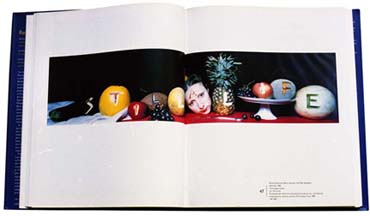
"For the "still performances" which become their "photoglyphs," the Gerlovins photograph their own faces and bodies marked with words and symbols, and produce larger-than-life color prints that are witty, intriguing, and seductive... skin becomes "human parchment" for their 'organic formulas." These theatrical portraits present the artists as literal "figures of speech," and are more cosmic than wordily in spite of the fleshy realism of the photographs.
Their images create a visual anthropomorphic poetry that is simultaneously humorous and serious. With titles as To Be, Absolute-relative, A-head, and Still-a-Life, the work entails multiple layers of punning, metaphor, and analogy operating at visual and textual levels. The works' dense references span languages, religions, cultures, and history, and draw equally on mysticism, mythology, mathematics, linguistics, and philosophy... Their partnership is founded upon the dynamic symmetry of masculinity and femininity."
Reflections in a Glass Eye Works from the International Center of Photography Collection, a Bullfinch Press Book, Little, Brown and Company, 1999, pp. 47, 216.
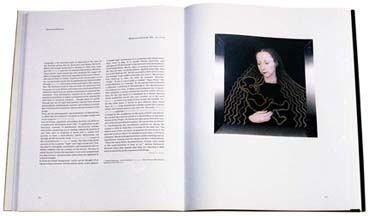
"They developed a concept of art which studies questions according the higher ontological truth, placing the individual in universal contexts. Through plays of words, through the use of signs and symbols derived from diverse philosophical, mythological, esoteric, and religious cosmologies and hierarchical systems, they probe the frontiers of language...
In front of a black background, which can be thought of as representing a timeless and boundless space, a face appears in bright light... It is usually Rimma Gerlovina, who emerges to fill the format in the harmoniously balanced pictorial composition. Words, signs, or numbers have been written into her skin. Applied externally, they are in the flesh for life. Yet the association that what is internal emerges to be visible externally also sets...
"There are many forms of presentation of truth, each suited to the understanding of each of us," declare Gerlovina/Gerlovin when they explain that they are referring in their work to humanity as the measure of all things."
Beate Ermacora, from the book The Promise of Photography, The DG Bank Collection, Prestel, Münich-London-New York, 1999, pp. 134-135.

"The piece by Rimma Gerlovina and Valeriy Gerlovin, conceptual artists who left Russia in 1980 and are now American citizens, is allegorical description of the Soviet Union. The hands are painted with the laurel crown that the Soviet empire awarded itself in grandiose emulation of its Roman antecedent... The central figure represents the all-seeing eye of the state: the two that flank it depict tears running down the face of Mother Russia."
The New York Times Magazine, The Millennium Issue on Art, September 19, 1999, spread pp. 118-119.
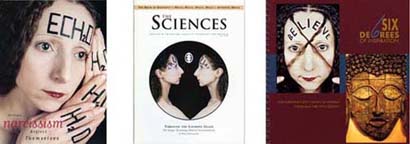
Covers: Narcissism. Artists Reflect Themselves, catalog for group exhibition at California Center for the Arts Museum, Escondido,CA,1996; The Sciences, magazine, May-June, 1997; Catalog for group exhibition Six Degrees of Separation, Contemporary Art Center of Virginia, 2000.

"Their images are simple, though laden with mythic and political content, and the vehicle for these images - their own bodies - is unforgettable. Because their range of their subjects is great - from eastern philosophy to Christian iconography, from alchemy to numerology - the Gerlovins' art is at once avant-garde and timeless."
Lois Fichner-Ratus, book Abnormal Psychology in a Changing World, Prentice-Hall, 1997, pp. 234, 492.
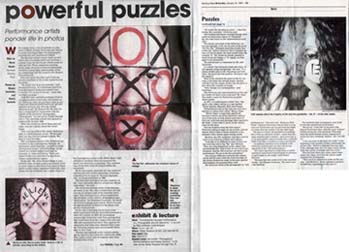
"With a single word, a set of symbols or a dramatic coiffure, Rimma Gerlovina and Valeriy Gerlovin turn bigger-than-life photographic self-portraits into intellectual riddles..."We never view it as our portraits," said Rimma. "It's us but it's not us - more like sending a message." "We want to provoke thinking."... The brief text that accompanies each work invites this intellectual involvement."
Marty Shuter, "Powerful Puzzles" ("Photoglyphs" at Telfair Museum of Art), Morning News, Savannah, GA, Sunday, Jan. 12, 1997

"The Gerlovins produce "photoglyphs," a term they originated to describe their gorgeous color photographs of mind-bending non sequiturs written on the artists' bodies and faces... concoct multiple, contradictory, logic-defying situations. They mirror our time...
Theories advanced by such renown scientists as David Bohm conform that the illogical unification of dichotomies actually abounds in the universe...The Gerlovins, like Bohm, disturb the elemental assumptions that constitute Western world order...
"We view art only as a vehicle (sic) to obtain a spiritual experience that transcends the intellect." (the Gerlovins) In search of a means "to transcend the intellect," the artists revised an old, venerated Russian art tradition, religious icon painting. Their photoglyphs are vested in this legacy. Like the painted icon, they dematerialize the physical world and arrest time. Their subject is, most often, Rimma's porcelain face, which glows with the grace and enigmatic calm of a Madonna. Furthermore, the photoglyphs recapitulate the format of an icon. Rimma's figure is positioned centrally in the composition. She exists in a dark space devoid of references to the mundane world. Her "still performances," as she calls them, consist of poses, facial expressions, and gazes that speak of eternity. Rimma embodies the mysticism of the Russian icon. These works envision a nondimensional, nontemporal, nonphysical world."
Linda Weintraub, from the book Art on the Edge and Over by Linda Weintraub, Arthur Danto, Thomas McEvilley, Art Insights, Inc., Publishers, 1996, pp.21, 236-241.
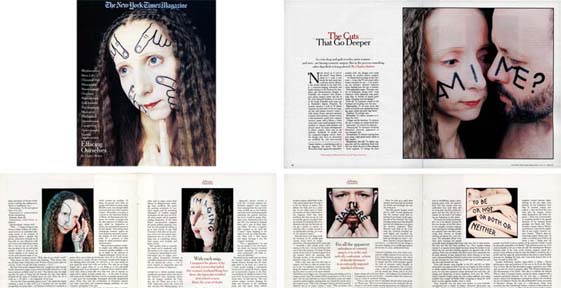
"On the cover: "Conspicuous," by Rimma Gerlovina and Valeriy Gerlovin, husband-and-wife artistic collaborators who use their own faces and bodies to explore the nature of language and thought. Born in Russia, the Gerlovins have lived and worked in the United States for 16 years." The New York Times Magazine, July 7, 1996, cover, pp. 4, 20-25.
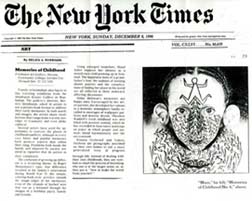
"Rimma Gerlovina and Valeriy Gerlovin use pictographs inscribed on their own bodies to tell a more generalized story of progress through life. Instead of dealing with their own childhoods, they use symbols to chart the process of becoming who one is in a larger sense, or, as they put it, "how to make the world from yourself."
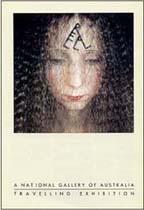
"The works serve... perhaps as tools for unlocking the realm of the unconscious. The Gerlovins' intriguing portraits present a perfect balance of body and mind, image and text."
Kate Davidson, catalog for the exhibition Beyond Recognition. Contemporary International Photography, National Gallery of Australia, 1996, back cover and poster.
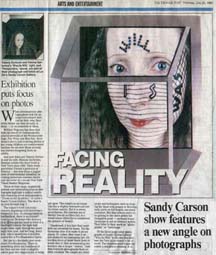
"Their work has won them a juggernaut of international attention including numerous museum shows and the cover of a recent New York Times Magazine... The couple's work has many charms, beginning with Gerlovina's wonderful face... there is an almost-translucent Madonna-like delicacy to it. If you put her head in front of a flashlights's beam, the light well might shine right through her piercing blue eyes. And her long, wavy hair, which sometimes is braided, makes her a Pre-Raphaelite figure...
Unadorned, it is a face that could hold our attention for hour. Yet, the Gerlovins alter it to make it an art object. Or rather, they treat it as raw material for conceptual art. Often they draw or paint black lines or words onto it, thus incorporating her features into a larger "canvas"...They are out to do something more than photograph beauty in a clever way, new way. They want to photograph wisdom – or at least a visual equivalent for it. And I think they do." Steven Rosen, "Facing Reality" The Denver Post, July 25, 1996.
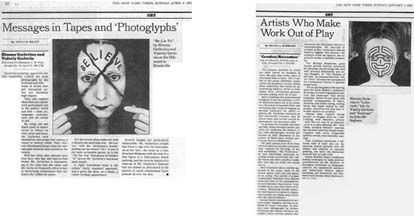
"Harsh but gripping, aggressive but also beautifully crafted, the large photographs by this husband-and-wife team of conceptual artists are decidedly high impact. They also explore ideas that are considered particularly hot in the gallery world – body art, language, cynicism, puns and the notion of self. By using red and black paint to depict forms and letters on their arms and faces, the Gerlovins turn themselves into props that convey a visual or mental riddle. Their cleverly illuminated larger-that-life photographs intensify and transform the results.
With her white skin, almond eyes, oval face, thin lips and high-arched brows, Ms. Gerlovina is mesmerizing in the role that she takes, and Mr. Gerlovin frequently offers a burly, terrorizing countenance that animates the riddle he poses...
Several images are particularly memorable: Ms. Gerlovina's braids that form a cage over the bird painted on her face; the artist as a cool, detached Madonna with the look of a holy figure in a 15th-century Dutch painting, and the reverse repeats of a close-up of Mr. Gerlovin's features that are almost as abstracted as the pattern of small schematized faces painted all over his skin."
Phyllis Braff, "Messages in Tapes and "Photoglyphs" ("Photoglyphs" at Hillwood Art Museum), The New York Times, Sunday, April 9, 1995. Left image: Helen A.Harris, "Artists Who Make Work Out of Play" (group exhibition at Islip Art Museum) ,The New York Times, Sunday, January 7, 1996
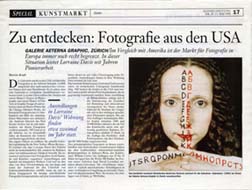
"Zu entdecken: Fotografie aus den USA" (Galerie Aeterna Graphic, Zürich), Handelszeitung, 5.15.1996, Zürich, Switzerland.
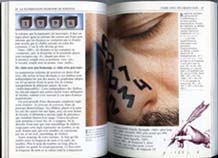
Denis Gued, L'empire des nombre, Decouvertes Gallimard, Paris, France,1996, pp. 48-49.
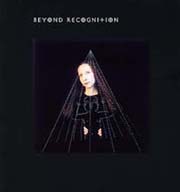
"As in many of the Gerlovin's photoglyphs, Rimma possesses both a physical and spiritual presence. The materiality of her face and hands is accentuated because it stands in contrast to the ephemerally outlined form of the child she holds. On the other hand, the sense that her form is emerging out of the darkness and is united within the dotted white lines that form both light and child, and her resemblance to Renaissance angelic figure types helps to elevate her form to a spiritual realm. The integration of the artists's human form from within the overall design in Light suggests that she is not merely a bystander at the moment of creation, but an essential and powerful participant in the process. Ultimately, the strength of these works resides in the tension the Gerlovins establish, with a combination of solemnity and wit, between physical and spiritual presence."
Ann Dawson and Laura Tonelli, Beyond Recognition, catalog for the traveling group exhibition, 1996 - 1997, cover.

Covers: Terry Barrett, Lessons for Teaching Art Criticism, The U.S. Department of Education, 1995; Westchester Life Style (Exhibition "Making Faces" at Hudson River Museum), March, 1995; The Progressive Corporation Annual Report, 1996 (link to the pages); 16-th Annual New Music Art Festival, Fine Arts Center, Bowling Green State University,OH, 1995.
<biography главная страница > назад1996 -1977 >